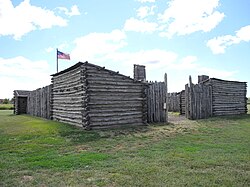Lewis and Clark Expedition
The Lewis and Clark Expedition was an expedition by Meriwether Lewis (1774–1809) and William Clark (1770–1838), two men chosen by United States President Thomas Jefferson to explore the Louisiana Purchase territory, which the country had just bought from France. (This land was made up of much of what is now the Central and Western United States). They left Saint Louis in 1804, leading a group of 33 people.[1] The group reached the Pacific in 1806, viewing much of the West on the way and writing down what they saw. Along the way, the group was joined by a Shoshone Native American woman named Sacagawea, helped guide and translate for them.[2] After their exploration, Lewis became Governor of Louisiana Territory, and Clark became Governor of Missouri Territory.[3] The only person that died on the trip was Sergeant Charles Floyd, Jr. He died on August 20, 1804 from Dysentery. It was a very good expedition for the United States of America.
Lewis And Clark Expedition Media
Camp Dubois (Camp Wood) reconstruction, where the Corps of Discovery mustered on the east side of the Mississippi River, through the winter of 1803–1804, to await the transfer of the Louisiana Purchase to the United States
Corps of Discovery meet Chinooks on the Lower Columbia, October 1805 (Lewis and Clark on the Lower Columbia painted by Charles Marion Russel, c. 1905)
Reconstruction of Fort Mandan, Lewis and Clark Memorial Park, North Dakota
Lewis and Clark meeting the Salish at Ross Hole, September 4, 1805.
Fort Clatsop reconstruction on the Columbia River near the Pacific Ocean
Statue of Sacagawea, a Shoshone woman who accompanied the Lewis and Clark Expedition
Lewis and Clark were honored (along with the American bison) on the Series of 1901 $10 Legal Tender
References
- ↑ "Lewis and Clark . Inside the Corps . The Corps". pbs.org. Archived from the original on September 26, 2011. Retrieved February 4, 2011.
- ↑ "Sacagawea". mathcs.bethel.edu. Archived from the original on July 12, 2015. Retrieved February 4, 2011.
- ↑ "Lewis & Clark National Historic Trail - Meriwether Lewis (U.S. National Park Service)". nps.gov. Retrieved February 4, 2011.









